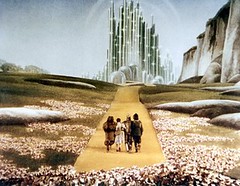
PREV ARTICLE
NEXT ARTICLE
FULL ISSUE
PREV FULL ISSUE
MICHAEL MAROTTA ON THE WIZARD OF OZ PARABLE Reader Michael E. Marotta is working on an article taking issue with the thesis put forth by several numismatists that The Wizard of Oz, with its yellow brick road and originally silver (not ruby) slippers was meant as a parable on the Gold and Silver Question of 1896. He submitted a preview (excerpted here) together with a bibliography too lengthy for publication here. Contact me or Michael for a copy if interested. -Editor  The theory that The Wonderful Wizard of Oz is a “parable about populism” originated with Henry M. Littlefield. “The Wizard of Oz: Parable on Populism.” American Quarterly, Vol. 16, No. 1 (Spring, 1964, pp. 47-58. Johns Hopkins University Press). The theory that The Wonderful Wizard of Oz is a “parable about populism” originated with Henry M. Littlefield. “The Wizard of Oz: Parable on Populism.” American Quarterly, Vol. 16, No. 1 (Spring, 1964, pp. 47-58. Johns Hopkins University Press). Littlefield was the first to explicitly identify the Scarecrow as the Farmer, the Tinman as the Industrial Worker, the Cowardly Lion as William Jennings Bryan, the Wizard “might be any President from Grant to McKinley.” In the original story, Dorothy is given silver, not ruby slippers. The Yellow Brick Road is the gold standard. In retelling the theory 25 years later, political science professor Michael A. Genovese wrote: “The allegory begins with the title. Oz is the abbreviation for ounce, the standard measure used for gold.” In 1989, economics professors Michael Watts and Robert F. Smith pointed out that oz stands for an ounce of both silver and gold. According to economics professor Hugh Rockoff: “The cyclone is the free silver movement itself. It came roaring out of the West in 1896, shaking the political establishment to its foundations.” In 1991, Mitchell Sanders found meaning in the magical golden cap. “The existence of the magical cap thus represents a twisted version of the Golden Rule: whoever owns the gold makes the rules.” Similar emendations and amendments are in many of the retellings. Littlefield himself actually published something of a retraction, in the opinion pages of the New York Times for February 7, 1992: “…there is no basis in fact to consider Baum a supporter of turn-of-the-century Populist ideology. … Baum's story may be taken as a parable on Populism, not a Populist parable. … We will never know if Baum had any conscious allegory in mind. I still think of the possibility of political allusions in “The Wizard of Oz” as a kind of undercurrent, a context. My original point in the article was not to label Baum, or to lessen any of his magic, but rather, as a history teacher at Mount Vernon High School, to invest turn-of-the-century America with the imagery and wonder I have always found in his stories.” Despite that, the theory has taken on a life of its own. Speculations continue, in part, because the circumstantial evidence is strong. The salient point for numismatists is that the idea did not begin with Walter Breen. In fact, none of the 26 works I have found on this subject cites Breen. Some cite no one, the author taking full credit for the ideas of others. Fact or fantasy? We've discussed the topic in prior E-Sylums, and we'll look forward to the publication of Michael's article. -Editor Wayne Homren, Editor The Numismatic Bibliomania Society is a non-profit organization promoting numismatic literature. See our web site at coinbooks.org. To submit items for publication in The E-Sylum, write to the Editor at this address: whomren@gmail.com To subscribe go to: https://my.binhost.com/lists/listinfo/esylum All Rights Reserved. NBS Home Page Contact the NBS webmaster 
|